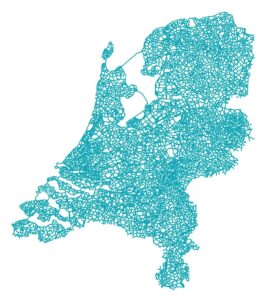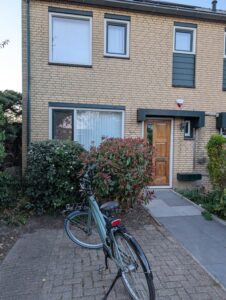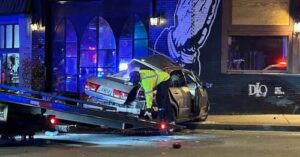 In the Netherlands, people are tightly packed. Less than one eighth of the country has anything built on it, including roads.
In the Netherlands, people are tightly packed. Less than one eighth of the country has anything built on it, including roads.
There’s a reason for this. The reason is water. When it rains, the water must have some place to go. The Netherlands has always been a fragile ecosystem, so its people have been supporting limits to development for 500 years.
A house on a lot, surrounded by grass, is just not a thing here, unless you’re talking about a castle. Everything people need must be packed into tight spaces, including the movement of people and goods.
 It’s land use, and the flatness of the land, that make bicycling a natural way to go.
It’s land use, and the flatness of the land, that make bicycling a natural way to go.
Here’s the math. It’s impossible to put 18 million people, and their cars, on 16,200 square miles of land, which is all the Dutch devote to it. A single parking space takes up 162 square feet. (A bike space takes 15.) Then remember the car needs a parking space where it shops, where it works, and where it lives. That’s over 480 square feet of space needed for each car, when it’s sitting. When it’s moving it needs more.
The practical space used by each citizen of the Netherlands comes to 376 square feet. That’s two Atlanta parking places. The house I’m in is on a lot of under 2,000 square feet and is designed for a family of 3. It’s considered suburban. Our house inside the city of Atlanta sits on 5,000 square feet and sleeps four. Our driveway alone is 300 square feet. It’s not a huge house.
Beyond Math

There’s a price to be paid, for being required to have a car. (This crash happened two miles from my home, last night.)

In addition to the roads, each car expects parking places that cost money. We haven’t even begun to count the financial cost of “accidents,” the lives lost or ruined, and the money spent policing those roads, or trying to.
All this spending is done because we’re convinced, whether we’re rich or we’re poor, that we need a car. So, the money gets spent, year after year. Our infrastructure crumbles under that weight, year after year. Those lives are lost, year after year.
What I’ve found in the Netherlands is that there’s another way. Just build around the idea that cars are not a necessity, but a choice.
The E-Transport Revolution

An e-bike frees you to travel 3-5 miles at a time, in comfort, something that wasn’t possible with an ordinary bike. But that’s just the tip of the spear, even in the Netherlands. Kids here ride fat-tired “Class 3” bikes that can go 28 mph, with minimal effort, so if your job is 10 miles away, and there are paths for the bike, you can get there.
What upsets me on the Netherlands bike paths is that they’re also used by motorcyclists. Under the law they shouldn’t be there. You need a helmet and a license to operate one. They stink, they’re loud, and they’re dangerous. But many Asian cities depend on such scooters and, as batteries get more energy density (lithium ion has 10% of gasoline’s energy density) range will improve and they’ll become practical. That’s just a few years away.

The e-transport revolution is already here. Those electric Amazon trucks save us from shopping trips. E-commerce can break bulk and deliver goods for less than the cost of breaking bulk at a store, and having people come get it.
All this means greater population density is possible. We don’t have to live the way we do. All we need to do is prepare our infrastructure to accept the changes that are already underway.










